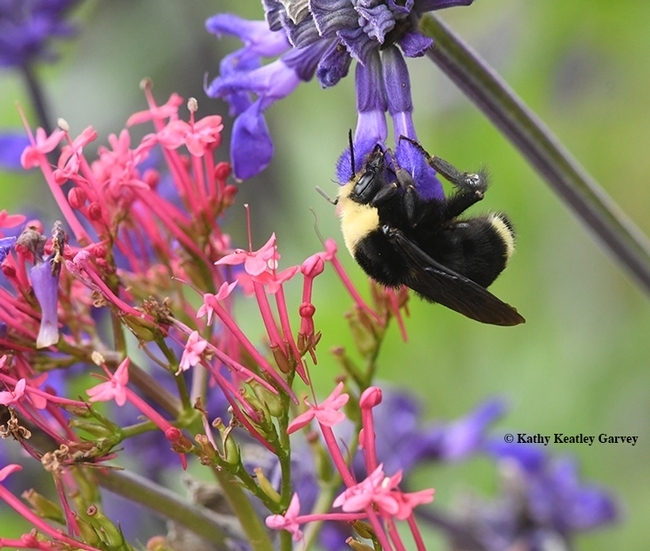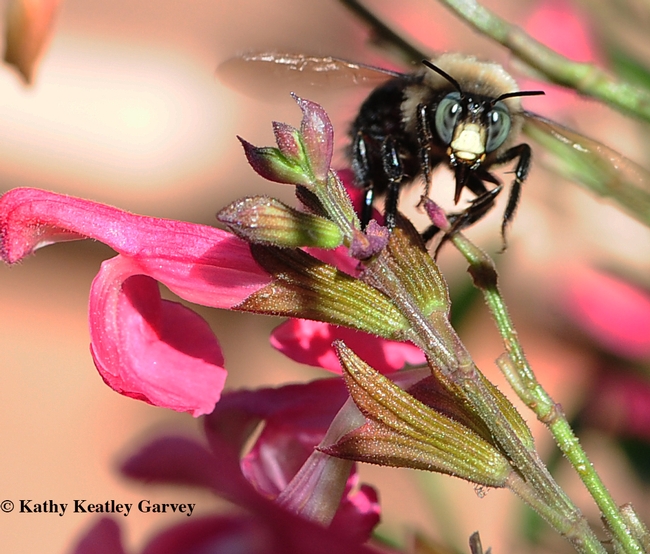- Author: Kathy Keatley Garvey
Bugs and bees. Bees and bugs.
That's what's on the menu--or that's what's buzzing--over the next few weeks in the Davis/Berkeley area.
Bugs.
Saturday, Sept. 21
Open House, Bohart Museum of Entomology Open House, UC Davis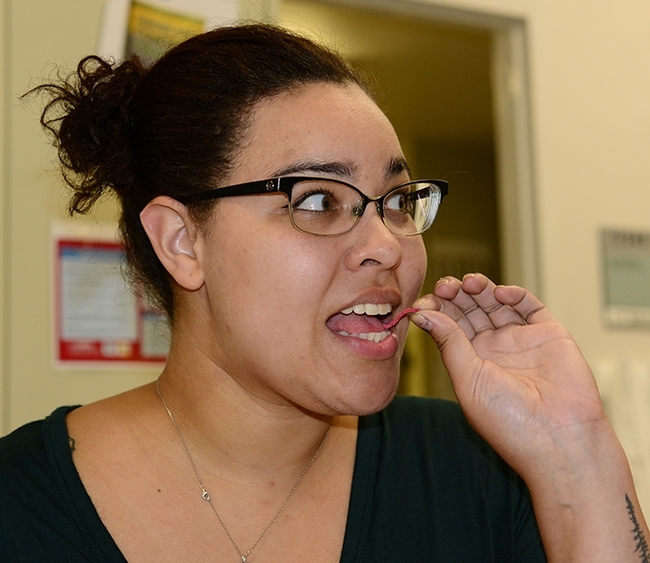
Or, you can view the global collection of insect specimens, cuddle a critter at the live "petting zoo" (think Madagascar hissing cockroaches, walking sticks and tarantulas) or buy a t-shirt, poster, jewelry, book, insect-collecting equipment and more in the gift shop.
The Bohart Museum, directed by Lynn Kimsey, professor of entomology at UC Davis, houses some eight million insect specimens, collected from all over the world.
Bees.
Wednesday, Sept. 25
Bee Seminar at UC Davis Department of Entomology and Nematology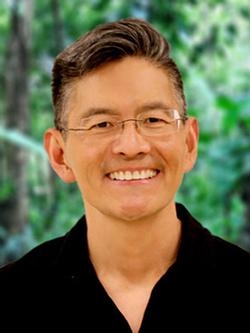
This is the first seminar in the series of fall quarter seminars sponsored by the UC Davis Department of Entomology and Nematology and coordinated by Rachel Vannette, assistant professor.
"In addition to the classical arm race that has evolved between predators and prey, information races also occur, which can lead to the evolution of sophisticated animal communication," Nieh says in his abstract. "Such information can shape the food web and contribute to the evolution of remarkable communication strategies, including eavesdropping, referential signaling and communication within and between species, including between predators and prey." Assistant professor Brian Johnson is the host.
Bees.
Saturday, Sept. 28
Open House, Häagen-Dazs Honey Bee Haven, UC Davis
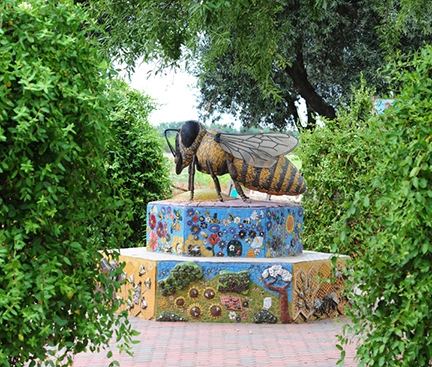
It will include sales of plants and native bee condos, honey tasting, catch-and-release bee observation and identification, and beekeeping and research displays. Several mini lectures are planned. Extension apiculturist Elina Lastro Niño serves as the faculty director of the bee garden, and Christine Casey as the manager. Casey announced today:
- See our analemmatic sundial, the only one of its kind in the Sacramento area. Speak with dial master and beekeeper Rick Williams, M.D., to learn about how the dial was created and the links between human and bee perception of the sun.
- Representatives from the California Master Beekeepers' Association will provide an introduction to beekeeping and do openings of the Haven's bee hive.
- Learn about our research on bee use of ornamental landscape plants
- Buy bee-supporting plants and solitary bee houses for your own garden
- Sample local honey from Sola Bee Honey
- Donate a book on insects, gardening, or nature for our Little Free Library
The garden was installed in the fall of 2019 under the direction of then interim department chair Lynn Kimsey, director of the Bohart Museum of Entomology and professor of entomology at UC Davis. A ceramic-mosaic sculpture of a six-foot long worker bee, the work of Donna Billick of Davis, anchors the garden. Its title: "Miss Bee Haven." The garden is open from dawn to dusk.
Bees.
Sunday, Oct. 13
Second Annual Bay Area Bee Fair, Berkeley Flea Market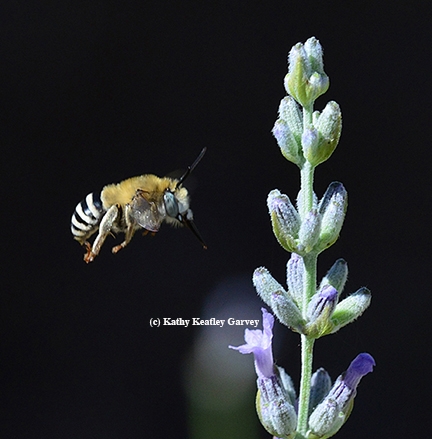
There will be kids' art activities, pollinator-themed art, and "education and inspiration for supporting bee and other pollinator populations." It's a place to learn about planting pollinator-friendly gardens and creating shelter/habitats.
One of the guest speakers will be bee scientist/professor Gordon Frankie of UC Berkeley, who co-authored the popular California Bees and Blooms: A Guide for Gardeners and Naturalists with Robbin Thorp, Rollin Coville and Barbara Ertter.
To get involved, reserve a booth, volunteer, or learn more, contact pollinatorpartiers@gmail.com. Or check out the website and Facebook page.
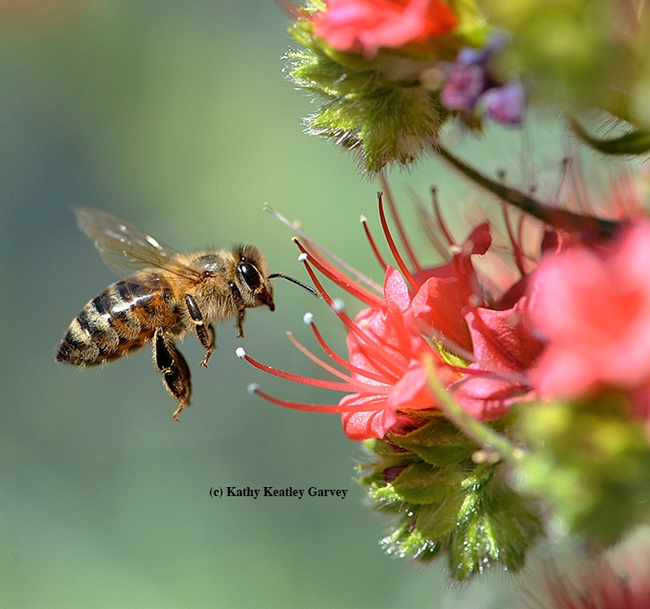
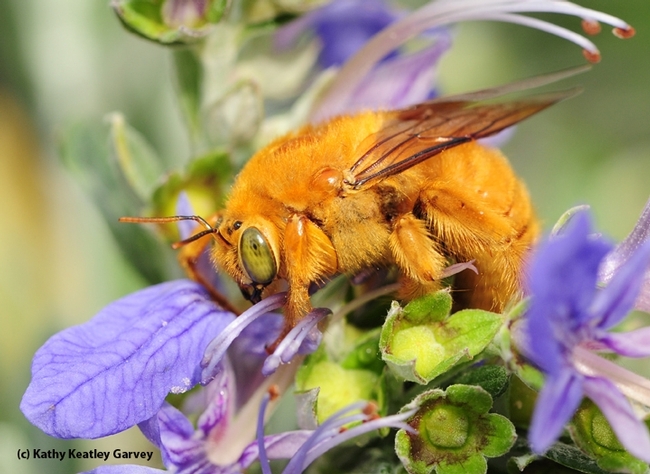
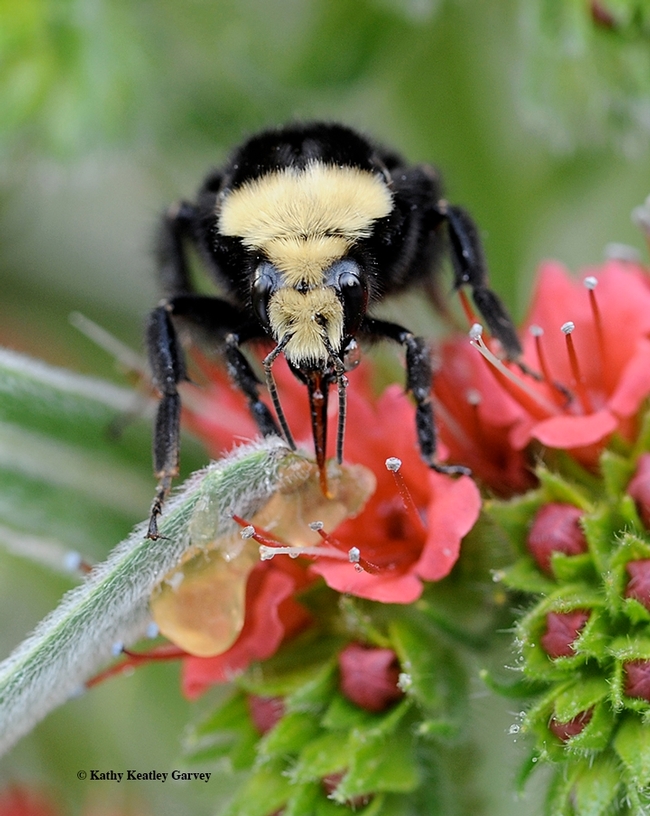
- Author: Kathy Keatley Garvey

Nine speakers are booked for the fall quarter seminars sponsored by the UC Davis Department of Entomology and Nematology. The seminars begin Wednesday, Sept. 25 and continue through Wednesday, Dec. 5.
Coordinated by assistant professor and community ecologist Rachel Vannette, the seminars will take place at 4:10 p.m., every Wednesday in Room 122 of Briggs Hall except on Nov. 20 (no seminar due to the Entomological Society of America meeting in St. Louis, Mo).
The schedule:
Sept. 25
James Nieh, professor, Section of Ecology, Behavior and Evolution, Department of Biological Sciences, UC San Diego
Topic: "Animal Information Warfare: How Sophisticated Communication May Arise from the Race to Find an Advantage in a Deadly Game Between Honey Bees and their Predators" (See lab website)
Host: Brian Johnson, associate professor, Department of Entomology and Nematology
Oct. 2
Nathan Schroeder, assistant professor, Department of Crop Sciences, University of Illinois, Urbana-Champaign
Topic: "Stem Cells and Neurobiology of Nematodes"
Host: Shahid Saddique, assistant professor, Department of Entomology and Nematology
Oct. 9:
John Mola, doctoral candidate, Neal Williams lab, Graduate Group in Ecology
Exit seminar: "Bumble Bee Movement Ecology and Response to Wildfire." Mola specializes in bee biology, pollinator ecology and population genetics.
Host: Neal Williams, professor, Department of Entomology and Nematology
Oct. 16:
Rebecca Irwin, professor, applied ecology, North Carolina State University, Raleigh, N.C.
Topic: (to be announced; she specializes in the ecology and evolution of multiple-species interactions, pollination biology, and species invasions)
Host: Rachel Vannette, assistant professor, Department of Entomology and Nematology
Oct. 23:
Julián Hillyer, director of the program in career development and associate professor of biological sciences, Vanderbilt Institute for Infection, Immunology and Inflammation, Nashville, Tenn.
Topic: "Not So Heartless: Functional Integration of the Immune and Circulatory Systems of Mosquitoes"
Host: Olivia Winokur, graduate student, Chris Barker lab
Oct. 30:
Takato Imaizumi, professor, Department of Biology, University of Washington, Seattle
Topic: Circadian Timing Mechanisms in Plant-Pollinator Interaction"
Host: Joanna Chiu, associate professor and vice chair of the Department of Entomology and Nematology
Nov. 6:
Brock Harpur, assistant professor, Department of Entomology, Purdue University
Topic: "Caste Differentiation in Honey Bees from the Bottom Up"
Host: Santiago Ramirez, associate professor, UC Davis Department of Evolution and Ecology, College of Biological Sciences
Nov. 13:
Allison Hansen, assistant professor, Department of Entomology, UC Riverside
Topic: Insect Herbivore-Microbe Interactions
Host: Clare Casteeel, assistant professor, UC Davis Department of Plant Pathology
Nov. 20:
No seminar (meeting of Entomological Society of America in St. Louis, Mo.)
Dec. 5:
Jackson Audley, doctoral candidate, Louie Yang lab and Steve Seybold lab
Exit seminar (topic to be announced). Audley studies the walnut twig beetle, Pityophthorus juglandis, which in association with the fungus, Geosmithia morbida, causes the insect-pathogen complex known as thousand cankers disease.)
Host: Steve Seybold, lecturer, forest entomology, UC Davis Department of Entomology and Nematology and forest entomologist and chemical ecologist with the Pacific Southwest Research Station, USDA Forest Service, Davis
The seminars are free and open to all interested persons. Some will be recorded for later viewing on YouTube. More information on the fall seminars or schedule is available from Vannette at rlvannette@ucdavis.edu.

- Author: Kathy Keatley Garvey
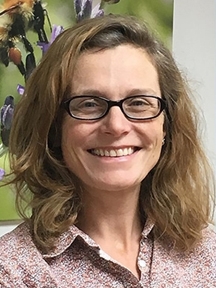
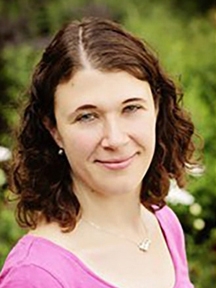
Yes, hummingbirds are pollinators, too!
A capacity crowd of 250 will attend the fourth International Pollinator Conference, to be hosted by the University of California, Davis, from Wednesday, July 17 through Saturday, July 20 in the ARC Ballroom.
A welcoming reception took place from 6:30 to 8 tonight (Wednesday) in the Good Life Garden at the Robert Mondavi Institute, 392 Old Davis Road.
Themed “Multidimensional Solutions to Current and Future Threats to Pollinator Health,” the conference will cover a wide range of topics in pollinator research: from genomics to ecology and their application to land use and management; to breeding of managed bees; and to monitoring of global pollinator populations.
Co-chairs are pollination ecologist Neal Williams and Extension apiculturist Elina Lastro Niño of the UC Davis Department of Entomology and Nematology. The UC Davis Honey and Pollination Center, directed by Amina Harris, is coordinating the conference. Events manager Elizabeth Luu serves as the conference coordinator.
Keynote speakers are Lynn Dicks, Natural Environment Research Council (NERC) Research Fellow, School of Biological Sciences, University of East Anglia, England, and Christina Grozinger, distinguished professor of entomology and director of the Center for Pollinator Research, Pennsylvania State University, (the research center launched the pollinator conferences in 2012).
Dicks will speak at 9 a.m., Thursday, July 18 on "The Importance of People in Pollinator Conservation" while Grozinger will address the crowd at 9 a.m., Friday, July 19 on "Bee Nutritional Ecology: From Genes to Landscapes."
Dicks, an internationally respected scientist, studies bee ecology and conservation. She received the 2017 John Spedan Lewis Medal for contributions to insect conservation. Grozinger studies health and social behavior in bees and is developing comprehensive approaches to improving pollinator health and reduce declines.
Among the speakers is Rachel Vannette, assistant professor, UC Davis Department of Entomology and Nematology, who will discuss her hummingbird research.
The agenda:
Wednesday, July 17
- 6:30 to 8 p.m.: Early Registration and welcome reception in the Good Life Garden at the Robert Mondavi Institute, 392 Old Davis Road, Davis.
Thursday, July 18
6:45 to 8:30 a.m., breakfast at Segundo Dining Commons
8:45 a.m. Opening remarks and welcome
9 a.m. Keynote Address: "The Importance of People in Pollinator Conservation" by Lynn Dicks, School of Biological Sciences, University of East Anglia, UK
10 a.m. Session 1: Novel Quantitative Methods in Pollinator Ecology & Management
- "The Role of Bee and Non-Bee Pollinators in Australian Open and Protected Cropping Systems (How do we overcome the pollination challenges?)" - Romina Rader, University of New England, Australia
- "Implementing a Honeybee Foraging Model and REDAPOLL Fruit Set Predictions in Washington State's Decision Aid System" - Vince Jones, Washington State University
- "Using DNA metabarcoding techniques to improve plant-pollinator interaction networks" - Victoria Reynolds, University of Queensland, Australia
- "Citizen Science Data for Mapping Bumblebee Populations" - Claudio Gratton, University of Wisconsin
11:15 to 11:30: Break (Light refreshments in the foyer) - "From Theory to Practice: The Bumble-BEEHAVE Model and its Application to Enhance Pollinator Friendly Land Management" - Matthias Becher, University of Exeter, UK
- "A Laboratory System to Study the Effects of Stressors on Honey Bee Health and Fecundity" - Julia Fine, USDA-ARS Davis, Calif.
- "Using Automated Tracking to Link Individual Behavior to Colony Performance in Bumble Bees" - James Crall, Harvard University
Lunch at Segundo Dining Commons (opens from 11:30 a.m. - 1:30 p.m.)
1:45 p.m. Session 2: Drivers of Host-Pathogen Interactions
- "DWV as a Driver of Host Bee Decline" - Robert Paxton, Martin-Luther University, Germany
- "Novel Transmission Routes and Intensification as Drivers of Disease Emergence and Virulence in Honey Bee viruses" - Mike Boots, UC Berkeley
- "Viral Transmission in Honey Bees and Native Bees Supported by a Global BQCV Phylogeny" - Elizabeth Murray, National Museum of Natural History, Smithsonian Institution
3 to 3:15: Break (Light refreshments in the foyer)
- "Drivers of Pathogen Distributions in Feral and Managed Honey Bees" - Panuwan Chantawannakul, Chiang Mai University, Thailand
- "Serratia marcescens, a Pathobiont of Honey Bees?" - Kasie Raymann, University of North Carolina Greensboro
- "Foreign Fungi in Native Bees across the Commonwealth of Virginia" - Kathryn LeCroy, University of Virginia
- "Traits as Drivers of Plant-Pollinator-Pathogen Networks" - Quinn McFrederick, UC Riverside and Scott McArt, Cornell University
4:30 p.m.: Poster Session 1 in the ARC Ballroom - 6:30 to 8 p.m. Opening Reception
Robert Mondavi Institute Sensory Building, 392 Old Davis Road, Davis
Honey Tasting led by Amina Harris, director, Honey and Pollination Center
Friday, July 19
6:45 a.m. to 8:30 a.m., Breakfast at Segundo Dining Commons
9 a.m. Keynote: "Bee Nutritional Ecology: From Genes to Landscapes," by Christina Grozinger, Penn State University
10 a.m. Session Three: Variable Climates and Changing Pollinators
- "Bee Responses to Climate Change: from Micro- to Macroecology" - Jessica Forrest, University of Ottawa, Canada
- "A Climate Vise of Temperature Extremes May Explain Past and Predict Future Bumble Bee Range Shifts" - Michael Dillon, University of Wyoming
- "Climate Change Effects on Megachilidae Bee Species along an Elevation Gradient" - Lindsie McCabe, Northern Arizona University
10:15 to 11:05: Break (Light refreshments in the foyer) - "Testing the Phenological Mismatch Hypothesis for a Plant-Pollinator Iinteraction" - Charlotte de Keyzer, University of Toronto, Canada
- "Phenological Mismatch between Bees and Flowers Early in the Spring and Late in the Summer" - Gaku Kudo, Hokkaido University, Japan
- "Climate Change Impacts on Brazilian Pollinators" - Tereza (Cris) Giannini, Federal University of Para, Brazil
- "Pollinator Health in a Commercial Blueberry System" - Lief Richardson, University of Vermont
Lunch at Segundo Dining Commons (opens from 11:30 a.m. - 1:30 p.m.)
Optional Discussion: How do you relate your science to justice, equity and advocacy issue
1:45 Session 4: Causes and Consequences of Pesticide Use: From Use Patterns to Pollination Services
- "A New Framework for Environmental Risk Assessment of Pesticides" - Francisco Sánchez-Bayo, University of Sydney, Australia
- "Potency Paradox: Patterns and Drivers of Insecticide Use in U.S. Agriculture" - Maggie Douglas, Dickinson College
- "Estimating Pollinator Pesticide Exposure" - Maj Rundlof, Lund University, Sweden
Break (Light refreshments in the foyer) - "A Risk Assessment of Neonicotinoid Insecticides in New York" - Travis Grout, Cornell University
- "Risk of Exposure in Soil and Sublethal Effects of Systemic Insecticides Applied to Crops on Adult Female Ground-Nesting Bees Using the Hoary Squash Bee as a Model Species" - D. Susan Willis Chan, University of Guelph, Canada
- "Delayed Lethality: The Effects of a Widely-Used Fungicide on Honey Bees (Apis mellifera)" - Adrian Fisher II, Arizona State University
- "Sub-lethal Impacts of Pesticides on Bees" - Troy Anderson, University of Nebraska
Poster Session 2 and Networking at the ARC Ballroom
Saturday, July 21
8 a.m. Registration at the ARC Ballroom
6:45 a.m. to 8:30 a.m.: Breakfast at Segundo Dining Commons
9 a.m.: Session 5: Integrative Approaches to Improving Bee Health Across Landscapes
- "Combining Physiological and Ecological Data for More Effective Bee Protection and Conservation" - Cedric Alaux, INRA, France
- "Keeping Bees in a Warming World: Protein Biomarkers for Heat Stress and Queen Failure Diagnostics" - Alison McAfee, North Carolina State University
- "Factors Influencing Colony Survival in Migratory Beekeeping Based on Honey Bee Resistance Traits" - Michael Simone-Finstrom, USDA-ARS, Baton Rouge, Louisiana
- "Temporal and Spatial Dynamics of Pollinator Communities across North Carolina Agroecosystem" - Hannah Levenson, North Carolina State University
- "The Effects of Land Cover on Habitat Quality for Nesting Bumble Bees" - Genevieve Pugesek, Tufts University
10 to 10:15 a.m. Break (Light refreshments in the foyer) - "Improving Bee Health in Canola Pollination" - Shelley Hoover, Alberta Agriculture and Forestry
- "Mitigating Land Use Decisions that Destroy Bee Forage" - George Hansen, Foothills Honey, Oregon, USA
- "Impact of Landscape-Scale Floral Resources Availability on Pollinator Communities" - Aaron Iverson, Cornell University
- "Why are Crops Mainly Visited by Broadly Polylectic Bee Species?" - Katja Hogendoorn, The University of Adelaide, South Australia
12:15 Lunch
1:40: Session 6: Pollinators in Urban Environments
- Presentation by The Wonderful Company
- Honoring new California Master Beekeeper graduates - Elina Niño, UC Davis
- "Floral Trophic Ecology of a North American Metropolis Revealed by Honey Bee Foraging Assay" -
Doug Sponsler, Penn State University - "Pollinators and Urban Warming: A Landscape Physiology Approach" - Elsa Youngsteadt, North
Carolina State University - "Green Infrastructure to Support Urban Wild bees: Communicating Science to Practitioners" - Scott
McIvor, University of Toronto, Canada - "Urban Pollinator Conservation Opportunities: Integrating Research with Policy and Practice" -
Katherine Baldock, University of Bristol, UK - "Linking Pollinator Health, Microbiome Composition and Human Provisioning in Anna's Hummingbird
(Calypte anna) - Rachel Vannette, UC Davis
Break (Light refreshments in the foyer) - "Beekeeping Ordinances: Protecting bees and Neighbors" - Tracy Ellis, San Diego County
Department of Agriculture - "Beekeeping in the City: Successes and Challenges" - Charlie Blevins, San Francisco Beekeepers'
Association - "Electric Power Companies Protecting Pollinators" - Jessica Fox, Electric Power Research Institute,
Palo Alto - "The Effect of Land use on a Sexually Selected Characteristic of the Cabbage White Butterfly (Pieris
rapae) in the United States" - Anne Espeset, University of Nevada, Reno - "Urban Pollinator Conservation: Bee Campus USA and Bee City USA as a Model for Meaningful
Community Engagement" - Phyllis Stiles, Xerces Society for Invertebrate Conservation, Portland,Ore.
(There are no plans to video-record the conference, according to Elizabeth Luu (luu@caes.ucdavis.edu) of the UC Davis Honey and Pollination Center, the events coordinator for the conference.)
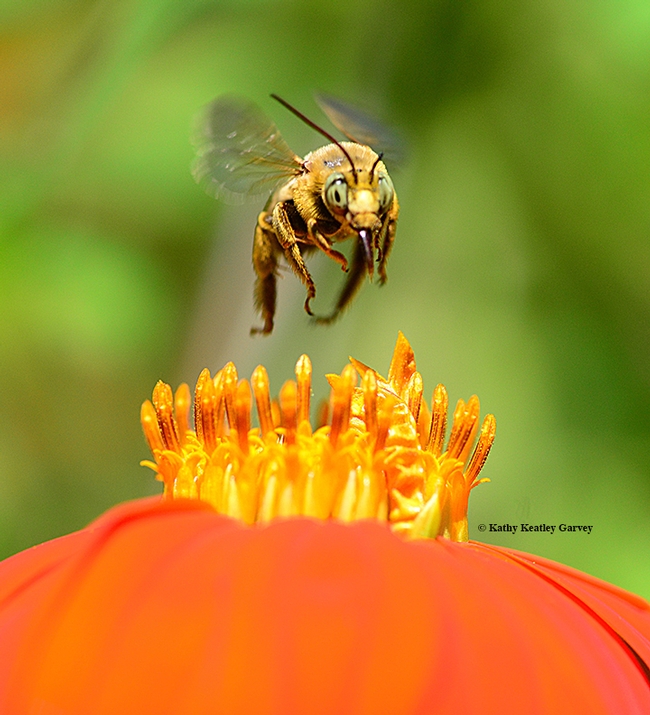
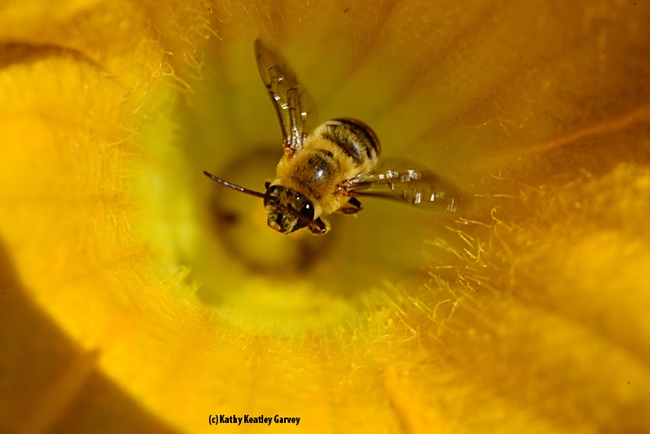
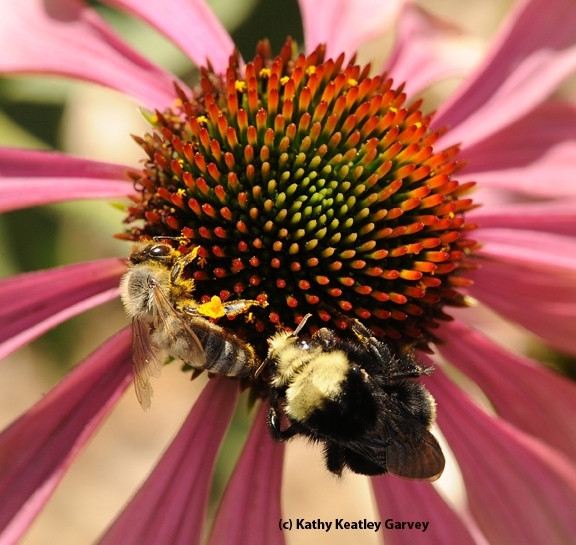
- Author: Kathy Keatley Garvey
When was the last time you sighted a bumble bee? Photographed it?
It's National Pollinator Week and one of our favorite bumble bees is the yellow-faced bumble bee, Bombus vosnesenskii. It was also a favorite of internationally renowned bee expert Robbin Thorp, distinguished emeritus professor of entomology at the University of California, Davis, who passed away June 7 at age 85. (See obituary)
In fact, all bumble bees were his favorite, including the elusive Franklin's bumble bee, found only in a small range in southern Oregon and northern California and now feared extinct. We remember a July 2010 interview with Thorp:
“People often ask the value of Franklin's bumble bee," Thorp told us. "In terms of a direct contribution to the grand scale of human economies, perhaps not much, but no one has measured its contribution in those terms. However, in the grand scheme of our planet and its environmental values, I would say it is priceless.”
“Loss of a species, especially a pollinator, diminishes our global environment,” he said. “Bumble bees provide an important ecological service--pollination. This service is critical to reproduction of a huge diversity of plants that in turn provide shelter, food (seeds, fruits) to diverse wildlife. The potential cascade of effects from the removal of even one localized pollinator may affect us directly and indirectly.”
Thorp treasured bumble bees and encouraged everyone else to do so, too.
The yellow-faced bumble bees are native to the west coast of North America, from Baja California to British Columbia. They're important pollinators, especially important for their buzz pollination of tomatoes, peppers and cranberries. Buzz pollination occurs when they grab a blossom and shake it, dislodging the pollen. Honey bees can't do that.
The Xerces Society for Invertebrate Conservation recently posted that one quarter (28 percent) of North American bumble bees are in some degree of extinction risk. "Bumble bees face many threats including habitat loss, disease, pesticide use, and climate change." (See more information on bumble bees on the Xerces' site.)
Meanwhile, "across the pond," London has established a seven-mile long bee corridor of wildflowers just for pollinators.
"The Intergovernmental Science-Policy Platform on Biodiversity and Ecosystem Services (IPBES) said wild mammals had declined by 82 per cent since 1980, space for natural ecosystems had halved, and one million species were now at risk of extinction as a result of human action," according to a May 7, 2019 article in The Independent newspaper. "Insect pollinators are vital for the maintenance of ecosystem health and for global food security. Insects are required to maintain the existence of 75 per cent of crop species, 35 per cent of global crop production and up to 88 per cent of flowering plant species," reporter Harry Cockburn wrote.
Want to learn more about the bumble bees around us? A good start is to read these two books, both co-authored by Thorp in his retirement: Bumble Bees of North America: An Identification Guide (Princeton University, 2014) and California Bees and Blooms: A Guide for Gardeners and Naturalists (Heyday, 2014).
And, if you would like to get involved in citizen science, Bumble Bee Watch seeks your sightings.
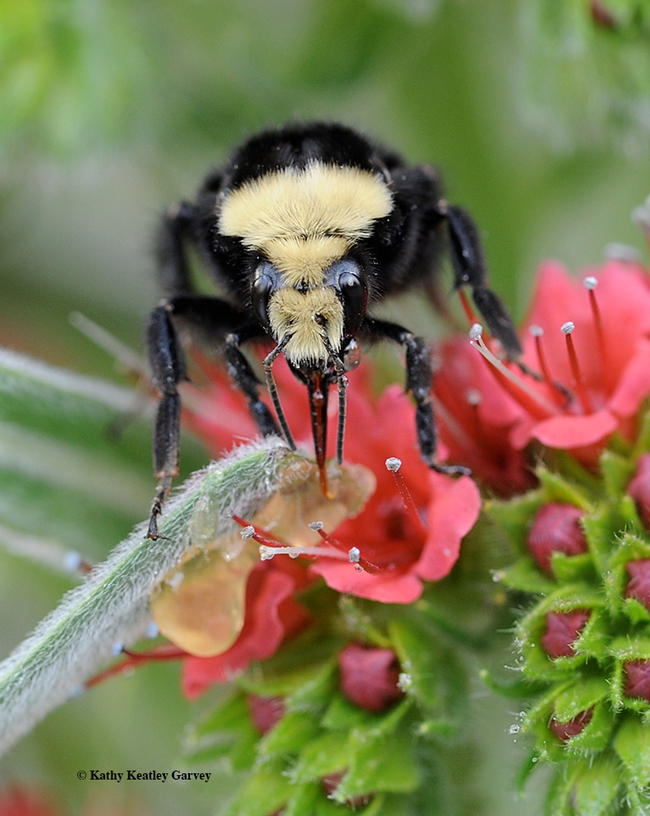
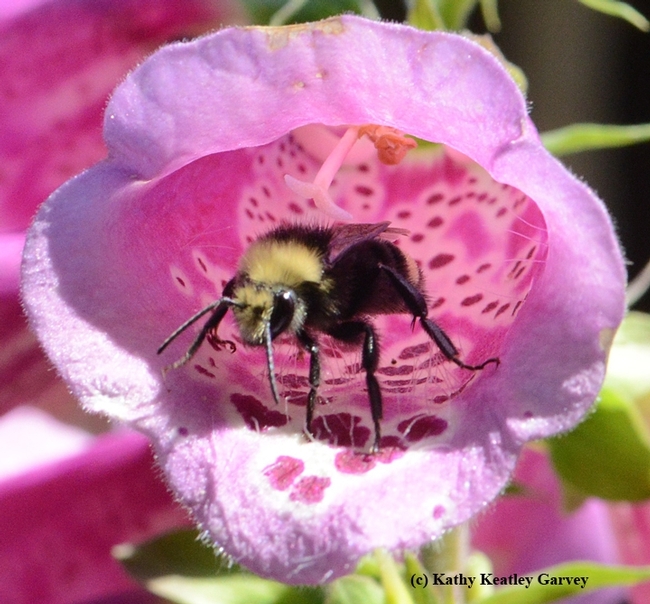
- Author: Kathy Keatley Garvey
Salivating over salvia?
You can see, salivate--and purchase--salvias and more at the spring premiere plant sale sponsored by the UC Davis Arboretum and Public Garden on Saturday, April 6.
They'll offer everything from "Bee's Bliss" to "Black Lace" to "Blaze" to "Brilliance." Among the many others: "Whirly Blue, "Pozo Blue," "Marine Blue," "Little Kiss," "Midnight," "Pink Cadillac" and "Hot Lips."
The plant sale, open to the public, is set from 9 a.m. to 1 p.m. at the one-acre Arboretum Teaching Nursery on Garrod Drive. It's a great place to buy plants to attract our pollinators: bees, butterflies, birds, beetles and bats. Not to mention syrphid flies, aka hover flies/flower flies!
You can download the plant sale inventory on the website. Favorites include the Arboretum All-Stars and California native plants, as well as herbs, perennials, shade plants, bushes, trees, vines and more.
Can't make it on Saturday, April 6? Plant sales are also scheduled Saturday, April 27 and Saturday, May 11.
Happy spring! Happy salivating! And happy/hungry pollinators!
